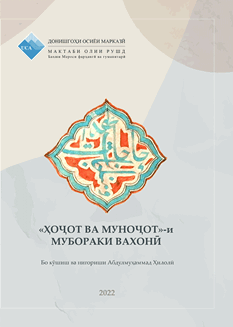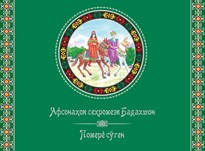‘The Needs and Litany: A Tajik Edition of Mubārak-i Wakhānī’s Ḥājāt va Munājāt’
Mubārak-i Wakhānī (d. 1903) was by far the most productive author in nineteenth-century Badakhshan. Andrey Bertels once observed that Wakhānī was ‘the Avicenna of Badakhshan’, whose intellectual accomplishments exceeded the limits of his geographic and intellectual environment. Examination of Wakhānī’s works reveals that he was well grounded in the Persian and Arabic languages, the religious sciences, poetry, astronomy, music and art. His intellectual legacy includes over sixteen titles covering a wide array of topics, which seek to establish a state of equilibrium between Ismaili and Sufi ideas expressed in the finest mystical spirit. Most of the original manuscripts are kept in in his museum in Tajikistan, but also in the private collections of his relatives in Tajik and Afghan Badakhshan. The manuscripts have leather bindings and are relatively well preserved. He produced his own papers using special techniques and tools.
As a prolific writer of the local literary tradition, Wakhānī considerably enriched the so-called ‘Sufisized Ismailism’ of Badakhshan by creating a harmony between Ismaili esotericism and Sufi mysticism. His works present a unique window into understanding the cultural specificities of the people of Badakhshan. One of his works where this idea shines most is called Ḥājāt va Munājāt (‘the Needs and Litany’). It is a part of Wakhani’s MS 05 written in 1897, which also includes Ṭālib al-Maṭlūb (‘A Seeker of the Sought’). Ḥājāt va Munājāt is the only work of Mubarak, which is written in the musajjaʾ or sajʾ (a rhythming pattern of words) – a style which combines elements of both prose and poetry. This style was popular in Arabic/Persian poetry in the past and one of its best examples is Munājāt-nāma of Abdullah Ansari – an eleventh century Persian poet and Sufi from Herat. It should be emphasised that musajjaʾ style is mainly popular in the Sufi writings. This Tajik edition of Ḥājāt va Munājāt is based on the original Persian manuscript of Wakhānī, which is kept in his museum in the Yamg village of Tajikistan. It consists of 84 good-preserved folios (168 pages), though few folios are slightly damaged (50, 58, 64, 71). The current Tajik Edition includes an introduction to the work, the original text with footnotes, a glossary of Arabic/Persian words and some illustrations.








